Edibles to grow in a mediterranean-climate garden:
Vegetables
Marrow Cucurbita pepo
by Charithea Joynes, Cyprus
Our marrows are grown in a plot that is irrigated along with our fruit trees. In Cyprus they are known as glykokoloko or sweet marrow. When young and small they are cooked with fresh black-eyed peas and served with oil. But a few are left to grow on and they gradually turn red and can be used to make a variety of sweet rather than savoury dishes, for example marrow crumble.
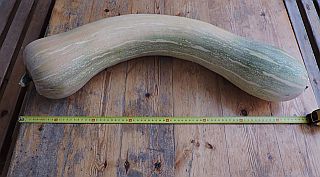
Full-sized marrow ready for use in sweet dishes
Recipe: Marrow and Pecan Crumble
Ingredients
1 kg marrow flesh
100 gm raisins
100 gm pecan nuts (we use pecans from our tree but walnuts could work)
100 gm brown sugar
For the crumble blend together:
150 gm plain flour
75 gm sugar
100 gm butter
Remove the outer skin of the marrow and cut into small cubes. Place in an oven-proof dish.
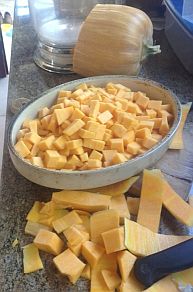
Add brown sugar and cover dish with foil. Place in oven for 1 hour at 200⁰C.
Remove from oven, add raisins and chopped pecan nuts. (Pecans and walnuts taste better if roasted for a few minutes before chopping).
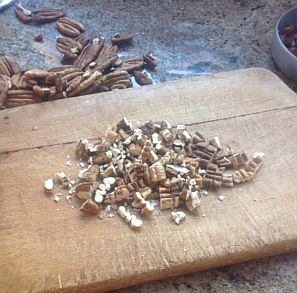
Cover with crumble.

Place in oven for 1 hour at 180⁰C to cook and brown.
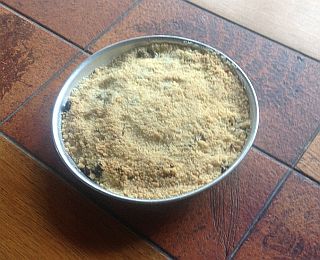
December 2015
Sweet Potato Ipomoea batatas
by Silke Bernau, Spain
In January, I put in several very small plants (about 30 cm-long, 2 or 3 stems each) of both the lime-green-leaved and purple-leaved varieties, to shade the soil in a new bed quickly over the summer while I decided what to do with it. While I was pondering (I do tend to take a long time pondering), the sweet potato decided it was happy and went on the rampage. Next thing I know, there are giant tubers and they're exploding.
They get full sun all day as the garden is south-facing which they love; the soil is clayey but it's good, rich local garden soil newly brought (no rubble or plastic bits) so it wasn't additionally mulched or composted or fertilised. I do water regularly in summer (drip irrigation) while I slowly plant ground cover, create shade from trees and shrubs etc and remove most of the aspirational English lawn from the south-facing, completely unshaded garden which I inherited when we bought the house three years ago. I am not sure the sweet potato needs weekly summer water, but I don't think it could be called drought-resistant. The big leaves close to the ground seem to shelter small moths/flies; I’m not sure what they are but I tend not to worry too much about insects in the garden unless they wrestle a plant to its knees. Snails really do love the leaves which can make them look a bit tatty, but they don't strip the plants down to the ground, and I don't mind the lacy look too much.
The sweet potato grows readily from cuttings: no need for anything fancy, just cut off the ends of a vine, trim off the bottom leaves to leave, say, 4 or 5 of the newest leaves at the top, and stick in the soil. It's briefly taken aback for about a week and looks a bit limp, and then gets on with it. A very small number don't 'take', but I have enough so I can just cut some more and plant. The lime-green ones are significantly more vigorous than the purple. I'll be digging the year-old plants up shortly and replanting with cuttings. If you leave the tuber in the ground, I am told, they get bigger and bigger, which is not really practical in a decorative garden, and I imagine the bigger they get, the woodier they will taste.
I am tempted to say that in our climate sweet potato is almost foolproof.
December 2015
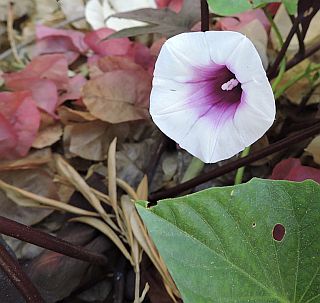
The attractive flowers of the sweet potato plant
Recipe: Sweet potato purée
Sweet potato can be boiled until soft and mashed with butter and milk, salt and pepper in the same way as ordinary mashed potato. It gives a smoother purée
Sweet potato is richer in nutrients than ordinary potato and is recommended as an ideal first food for young babies who enjoy the smooth sweetness. |


